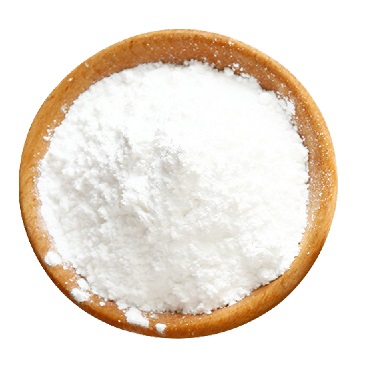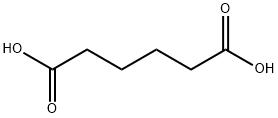-
外観
白色の結晶又は結晶性の粉末
-
定義
本品は、次の化学式で表されるジカルボン酸である。
-
性質
に溶けやすく、熱水やにも可溶です。水にわずかに溶け、水溶液は酸性を示します。
1分子あたり2つの酸性基を持ち、水中で2つのプロトンを放出できる二塩基酸の一つです。pKa値4.4と5.4において、2段階のプロトン解離を起こします。
2つのカルボン酸基が4つのメチレン基で隔てられているため、アジピン酸は分子内縮合反応します。を加えて高温で処理するとケトン化し、が生成します。
(CH2)4(CO2H)2 → (CH2)4CO + H2O + CO2
また、アジピン酸を高温で加熱すると、無水アジピン酸になります。
-
溶解性
水に難溶 (1.4g/100ml水, 15℃)。エタノールに易溶。アセトンに可溶。熱水、エタノール及びアセトンに溶ける。
-
解説
hexanedioic acid.C6H10O4(146.14).HOOC(CH2)4COOH.アジピン酸は,二塩基酸の一種.シクロヘキサノール,シクロヘキサノン,あるいはシクロヘキサンの酸化分解で得られる.アジポニトリルの加水分解によっても得られる.単斜柱状晶.融点153 ℃,沸点205 ℃(1.3 kPa),265 ℃(13 kPa).Ka1 253.76×10-5.エタノール,アセトンに可溶,エーテルにはほとんど不溶.ナイロン66の重要な製造原料,そのほかポリアミド繊維,アルキド樹脂,ポリエステル樹脂,可塑剤,医薬品などの合成原料としても大きな用途がある.LD50 1900 mg/kg(マウス,経口).森北出版「化学辞典(第2版)
-
用途
有機合成原料。
-
用途
ナイロン樹脂原料(ヘキサメチレンジアミンとナイロン66をつくる)?可塑剤DOA?塗料?医薬品原料?香料固定剤?有機合成?分析用試薬 吸湿性がなく、酒石酸、クエン酸の代用としてアストリンゼント、レモン乳液、ヘアリンスなどに使用される 化粧品原料(清浄用化粧品、頭髪用化粧品、基礎化粧品、メークアップ化粧品、芳香化粧品、日焼け?日焼け止め化粧品、爪化粧品、口唇化粧品、口腔化粧品、入浴用化粧品) 食品添加物(酸味料、乳製品ホイッピング改良剤、食用油脂品質改良、フレーバー増強剤)
-
製法
アジピン酸は、を酸化することにより得られます。まず、ケトンアルコールオイルと呼ばれるとシクロヘキサノールの混合物を用意し、これをで酸化することで、多段階の経路を経てアジピン酸を得ます。反応の初期にシクロヘキサノールはケトンに変換され、亜硝酸が放出されます。
C6H11OH + HNO3 → (CH2)5CO + HNO2 + H2O
多段階の反応過程で、次式に従ってシクロヘキサノンはニトロソ化され、C-C結合が切断されます。
HNO2 + HNO3 → NO+NO3- + H2O
OC6H10 + NO+ → OC6H9-2-NO + H+
この製法の副産物として、やがあります。ここにおいて、アジピン酸に対して約1対1のモル比で(N2O)が生成されます。
亜酸化窒素が発生しない、代替製造方法としては、次式に従ってをヒドロカルボキシル化する方法や、を用いてを酸化開裂させる方法が提案されています。
CH2=CH-CH=CH2 + 2 CO + 2 H2O → HO2C(CH2)4CO2H
-
化粧品の成分用途
pH調整剤、香料
-
効能
安定化剤, 錠崩壊剤
-
説明
Adipic acid is a crystalline powder with practically no odor. It has the lowest acidity of any of the acids commonly used in foods and has excellent buffering capacity in the range of pH 2.5 to 3.0. Like succinic and fumaric acid, adipic acid is practically nonhygroscopic. Its addition to foods imparts a smooth, tart taste. In grape-flavored products, it adds a lingering supplementary flavor and gives an excellent set to food powders containing gelatin. As a result, adipic acid has found a wide number of uses as an accidulant in dry powdered food mixtures, especially in those products having delicate flavors and where addition of tang to the flavor is undesirable.

Its aqueous solutions have the lowest acidity of any of the common food acids. For concentrations from 0.5 to 2.4 g/100 mL, the pH of its solution varies less than half a unit. Hence, it can be used as a buffering agent to maintain acidities within the range of 2.5 to 3.0. This is highly desirable in certain foods, yet the pH is low enough to inhibit the browning of most fruits and other foodstuffs.
-
化学的特性
Adipic acid is the organic compound with the formula (CH2)4(COOH)2. From the industrial perspective, it is the most important dicarboxylic acid: About 2.5 billion kilograms of this white crystalline powder are produced annually, mainly as a precursor for the production of nylon. Adipic acid otherwise rarely occurs in nature.
-
物理的性質
Adipic acid is a straight-chain dicarboxylic acid that exists as a white crystalline compound at standard temperature and pressure. Adipic acid is one of the most important industrial chemicals and typically ranks in the top 10 in terms of volume used annually by the chemical industry.
-
天然物の起源
Reported found as a minor constituent in butter, and has been found in other fats as a product of oxidative
rancidity. It also occurs in beet juice, pork fat, guava fruit (Psidium guajava L.), papaya (Carica papaya L.) and raspberry (Rubus
idaeus L.).
-
使用
Adipic Acid is primarily used in the synthesis of nylon. It has been used as a reagent in the solid-state polymerization of nylon analogs.
-
製造方法
Adipic acid is produced from a mixture of cyclohexanol and cyclohexanone called "KA oil", the abbreviation of "ketone-alcohol oil." The KA oil is oxidized with nitric acid to give adipic acid, via a multistep pathway. Early in the reaction the cyclohexanol is converted to the ketone, releasing nitrous acid:
HOC6H11 + HNO3 → OC6H10 + HNO2 + H2O
Among its many reactions, the cyclohexanone is nitrosated, setting the stage for the scission of the C- C bond:
HNO2 + HNO3 → NO+NO3- + H2O
OC6H10 + NO+→ OC6H9-2 - NO + H+
Side products of the method include glutaric and succinic acids.
Related processes start from cyclohexanol, which is obtained from the hydrogenation of phenol.
-
調製方法
Adipic acid is prepared by nitric acid oxidation of cyclohexanol or
cyclohexanone or a mixture of the two compounds. Recently,
oxidation of cyclohexene with 30% aqueous hydrogen peroxide
under organic solvent- and halide-free conditions has been
proposed as an environmentally friendly alternative for obtaining
colorless crystalline adipic acid.
-
定義
ChEBI: An alpha,omega-dicarboxylic acid that is the 1,4-dicarboxy derivative of butane.
-
反応性
Adipic acid is a dibasic acid (can be deprotonated twice). Its pKa's are 4.41 and 5.41.
With the carboxylate groups separated by four methylene groups, adipic acid is suited for intramolecular condensation reactions. Upon treatment with barium hydroxide at elevated temperatures, it undergoes ketonization to give cyclopentanone.
-
安全性
アジピン酸は、他のカルボン酸と同様に、軽度の皮膚刺激性があります。毒性は穏やかで、ラットに経口摂取させた場合の致死量は中央値で3600mg/kgです。
環境面としては、アジピン酸の生産において排出される亜酸化窒素(N2O)は、成層圏の層破壊を引き起こす物質であること、またの約300倍の温室効果を有することが指摘されています。そのため、この排出を抑制する必要があり、アジピン酸メーカーでは、次式に従って、亜酸化窒素を触媒作用によって窒素と酸素に変換するプロセスを導入しています。
2 N2O → 2 N2 + O2
-
一般的な説明
Adipic acid is a white crystalline solid. Adipic acid is insoluble in water. The primary hazard is the threat to the environment. Immediate steps should be taken to limit its spread to the environment. Adipic acid is used to make plastics and foams and for other uses.
-
空気と水の反応
Dust may form explosive mixture with air [USCG, 1999]. Insoluble in water.
-
健康ハザード
Exposures to adipic acid cause pain, redness of the skin and eyes, tearing or lacrimation.
Adipic acid has been reported as a non-toxic chemical. Excessive concentrations of adipic
acid dust are known to cause moderate eye irritation, irritation to the skin, and dermatitis.It may be harmful if swallowed or inhaled. It causes respiratory tract irritation with symptoms
of coughing, sneezing, and blood-tinged mucous.
-
使用用途
アジピン酸は、各種有機合成原料として使用され、特にナイロン-66やなどの高分子製造の原料モノマーとして多く利用されています。また、アルキド樹脂や医薬品等の合成原料としても利用されています。
アジピン酸は他にも、食品添加物として酸味料、品質改良剤、膨張剤等に使われています。また、酸の標準物質として、アルカリ標準液の標定にも用いられています。
アジピン酸をオクチルアルコール、デシルアルコール等とエステル化して得られるジエステルは、可塑剤や合成潤滑油として使用されています。
-
応用例(製薬)
Adipic acid is used as an acidifying and buffering agent in
intramuscular, intravenous and vaginal formulations. It is also
used in food products as a leavening, pH-controlling, or flavoring
agent.
Adipic acid has been incorporated into controlled-release
formulation matrix tablets to obtain pH-independent release for
both weakly basicand weakly acidic drugs.It has also been
incorporated into the polymeric coating of hydrophilic monolithic
systems to modulate the intragel pH, resulting in zero-order release
of a hydrophilic drug.The disintegration at intestinal pH of the
enteric polymer shellac has been reported to improve when adipic
acid was used as a pore-forming agent without affecting release in
the acidic media.Other controlled-release formulations have
included adipic acid with the intention of obtaining a late-burst
release profile.
-
安全性プロファイル
Poison by intraperitoneal route. Moderately toxic by other routes. A severe eye irritant. Combustible when exposed to heat or flame; can react with oxidzing materials. When heated to decomposition it emits acrid smoke and fumes.
-
安全性
Adipic acid is used in pharmaceutical formulations and food
products. The pure form of adipic acid is toxic by the IP route, and
moderately toxic by other routes. It is a severe eye irritant, and may
cause occupational asthma.
LD50 (mouse, IP): 0.28 g/kg
LD50 (mouse, IV): 0.68 g/kg
LD50 (mouse, oral): 1.9 g/kg
LD50 (rat, IP): 0.28 g/kg
LD50 (rat, oral): >11 g/kg
-
職業ばく露
Workers in manufacture of nylon, plasticizers, urethanes, adhesives, and food additives
-
概要
アジピン酸は、化学式(CH2)4(COOH)2で表される有機化合物です。工業的に最も重要なジカルボン酸で、白色で無臭の結晶性粉末です。別名、ヘキサン二酸、1,4-ブタンジカルボン酸とも呼ばれます。自然界で見られることは稀ですが、火焔菜(カエンサイ)など一部の植物に含まれており、さわやかな酸味があります。歴史的には種々の脂肪を酸化させることで調製していたため、ラテン語で「動物の脂肪」を意味するadeps、adipisを冠してアジピン酸と名付けられました。
-
貯蔵
Adipic acid is normally stable but decomposes above boiling point.
It should be stored in a tightly closed container in a cool, dry place,
and should be kept away from heat, sparks, and open flame.
-
合成方法
シクロヘキサンの酸化による方法,シクロヘキセンの水和と酸化による方法,ブタジエン法,過酸化水素による酸化
-
輸送方法
UN3077 Environmentally hazardous substances, solid, n.o.s., Hazard class: 9; Labels: 9-Miscellaneous hazardous material, Technical Name Required
-
純化方法
For use as a volumetric standard, adipic acid is crystallised once from hot water with the addition of a little animal charcoal, dried at 120o for 2hours, then recrystallised from acetone and again dried at 120o for 2hours. Other purification procedures include crystallisation from ethyl acetate and from acetone/petroleum ether, fusion followed by filtration and crystallisation from the melt, and preliminary distillation under vacuum. [Beilstein 2 IV 1956.]
-
不和合性
Adipic acid is incompatible with strong oxidizing agents as well as
strong bases and reducing agents. Contact with alcohols, glycols,
aldehydes, epoxides, or other polymerizing compounds can result in
violent reactions.
-
廃棄物の処理
Dissolve or mix the material with a combustible solvent and burn in a chemical incinerator equipped with an afterburner and scrubber. All federal, state, and local environmental regulations must be observed
-
予防処置
Occupational workers should avoid contact of the adipic acid with the eyes, avoid breathing
dust, and keep the container closed. Workers should use adipic acid only with adequate
ventilation. Workers should wash thoroughly after handling adipic acid and keep
away from heat, sparks, and flame. Also, workers should use rubber gloves and laboratory
coats, aprons, or coveralls, and avoid creating a dust cloud when handling, transferring,
and cleaning up.
-
規制状況(Regulatory Status)
GRAS listed. Included in the FDA Inactive Ingredients Database
(IM, IV, and vaginal preparations). Accepted for use as a food
additive in Europe. Included in an oral pastille formulation
available in the UK. Included in the Canadian List of Acceptable
Non-medicinal Ingredients.


